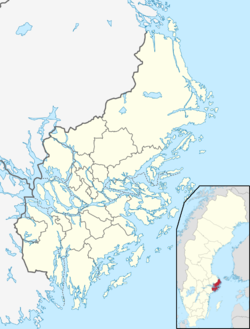It is proposed that this article be deleted because of the following concern:
If you can address this concern by improving, copyediting, sourcing, renaming, or merging the page, please edit this page and do so. You may remove this message if you improve the article or otherwise object to deletion for any reason. Although not required, you are encouraged to explain why you object to the deletion, either in your edit summary or on the talk page. If this template is removed, do not replace it . The article may be deleted if this message remains in place for seven days, i.e., after 11:48, 2 May 2025 (UTC). Find sources: "Eriksberg, Botkyrka" – news · newspapers · books · scholar · JSTOR Nominator: Please consider notifying the author/project: {{ subst:proposed deletion notify |Eriksberg, Botkyrka|concern=No significant coverage. Swedish sources indicate this is a loosely defined nickname; it's not a legally recognised place. Does not meet [[WP:NPLACE]]}} ~~~~ |
Eriksberg | |
|---|---|
Suburb | |
Location in Stockholm County | |
| Coordinates: 59°14′11″N17°50′16″E / 59.23639°N 17.83778°E | |
| Country | |
| County | Stockholm County |
| Municipality | Botkyrka Municipality |
| Time zone | UTC+1 (CET) |
| • Summer (DST) | UTC+2 (CEST) |
Eriksberg is a suburb of Botkyra in Botkyrka Municipality, Stockholm County, southeastern Sweden. It contains an industrial estate and residential area of around 3,200 people, mainly residing in high-rise buildings which were built in the mid-1970s, and lower buildings erected in the 1980s. The proportion of people with a foreign background as of 2003 was 34.8%.
